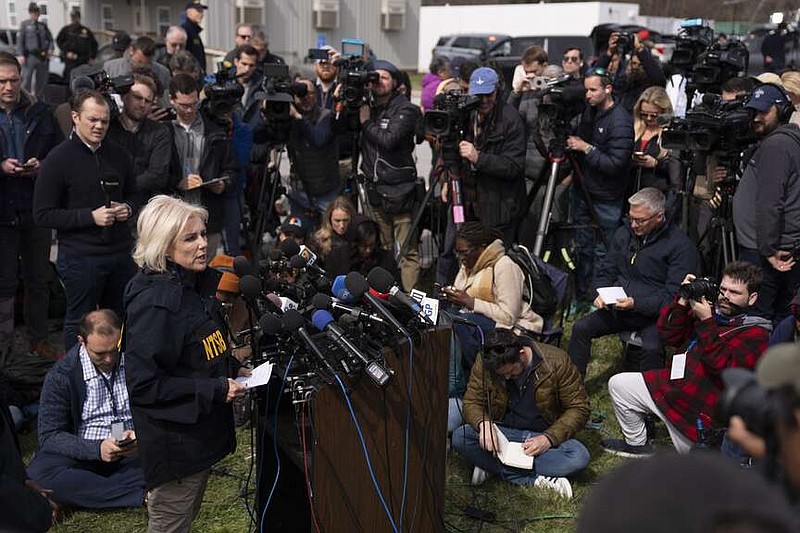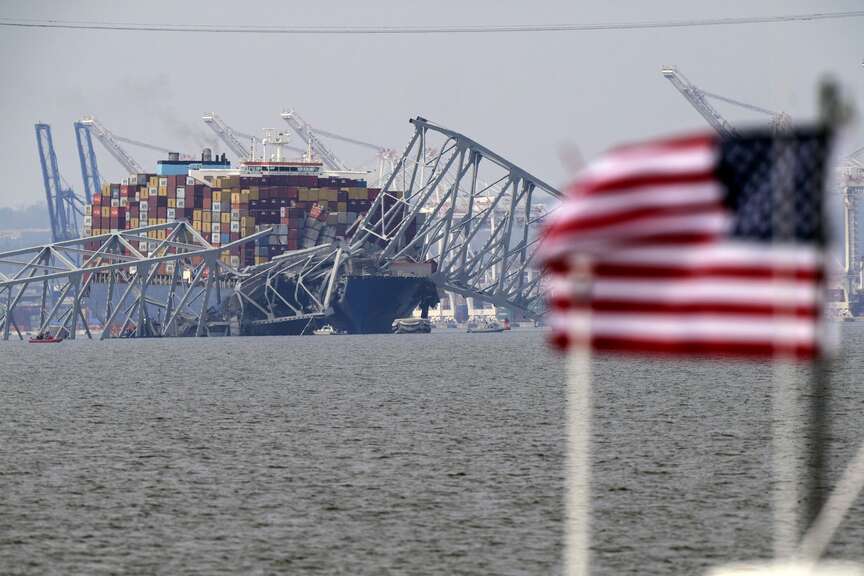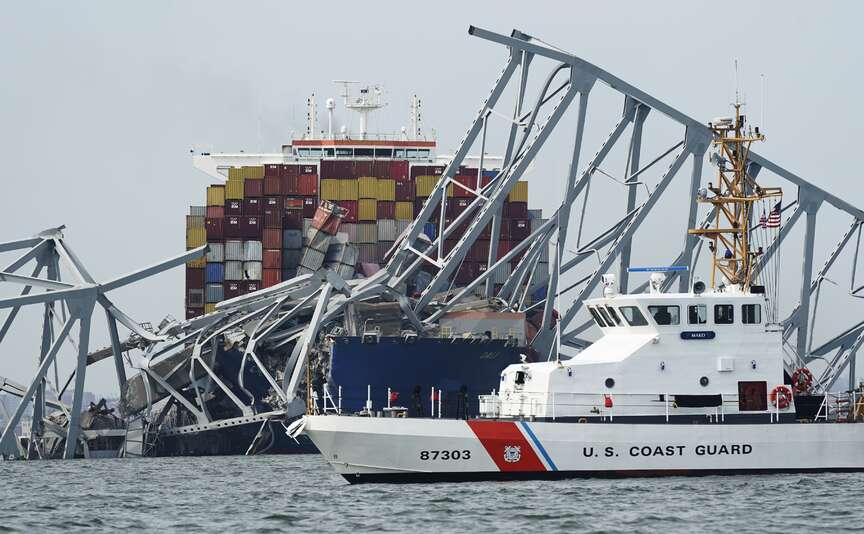BALTIMORE -- The stunning collapse of Baltimore's Francis Scott Key Bridge is diverting shipping and trucking around one of the busiest ports on America's East Coast, creating delays and raising costs in the latest disruption to global supply chains.
After the container ship Dali hit the bridge and brought it down early Tuesday, ship traffic entering and leaving the Port of Baltimore was suspended indefinitely. That will require rerouting vessels or their cargo to other ports, potentially causing congestion and delays for importers, said Judah Levine, head of research for the global freight booking platform Freightos.
"People right now are figuring out where are they going and what are their options," Ami Daniel, CEO of the maritime intelligence company Windward in Tel Aviv, Israel, said.
By day's end, a search for six missing people who were presumed dead was suspended until this morning.
The ship's crew issued a mayday call moments before the crash took down the Francis Scott Key Bridge, enabling authorities to limit vehicle traffic on the span, Maryland's governor said.
As the vessel neared the bridge, puffs of black smoke could be seen as the lights flickered on and off. It struck one of the bridge's supports, causing the structure to collapse like a toy, and a section of the span came to rest on the bow.
With the ship barreling toward the bridge at "a very, very rapid speed," authorities had just enough time to stop cars from coming over the bridge, Maryland Gov. Wes Moore said.
"These people are heroes," Moore said. "They saved lives last night."
In the evening, Col. Roland L. Butler Jr., superintendent of the Maryland State Police, announced that the search-and-rescue mission was transitioning to one of search-and-recovery. He also said the search was being put on pause and divers would return to the site at 6 a.m. today, when challenging overnight conditions were expected to improve. No bodies have been recovered, Butler said.
The crash happened in the middle of the night, long before the busy morning commute on the bridge that stretches 1.6 miles and was used by 12 million vehicles last year.
A few hours after the 1:27 a.m. collision, Baltimore Fire Department Chief James Wallace said authorities had detected the presence of vehicles in the water by using sonar. Water in the area is about 50 feet deep.
Authorities have not determined the precise cause, but U.S. Sen. Ben Cardin told The Sun in a phone interview that indications point to the vessel losing power, causing it to lose steering. He said the immediate focus is search-and-rescue and added that "there weren't too many occupied vehicles on the bridge."
A Coast Guard briefing report obtained by The Sun stated that "a harbor pilot and assistant were on board and reported power issues, multiple alarms on the bridge and loss of propulsion prior to the incident."
The six missing people were part of a construction crew filling potholes on the bridge, said Paul Wiedefeld, the state's transportation secretary.
LONG-TERM IMPACT
The Dali was the only container vessel in the port at the time of the collision, but seven others had been scheduled to arrive in Baltimore through Saturday, Levine said.
"Aside from the obvious tragedy, this incident will have significant and long-lasting impacts on the region," American Trucking Associations spokesperson Jessica Gail said, calling Key Bridge and Baltimore's port "critical components" of the nation's infrastructure.
Gail noted that 1.3 million trucks cross the bridge every year -- 3,600 a day. Trucks that carry hazardous materials will now have to make 30 miles of detours around Baltimore because they are prohibited from using the city's tunnels, she said, adding to delays and increasing fuel costs.
"Timewise, it's going to hurt us a lot," said Russell Brehm, the terminal manager in Baltimore for Lee Transport, which trucks hazardous materials such as petroleum products and chemicals. The loss of the bridge will double to two hours the time it takes Lee to get loads from its terminal in Baltimore's Curtis Bay to the BJ's gasoline station in the waterfront neighborhood of Canton, he estimated.
The accident comes as global shipping has largely adjusted to disruptions from Houthi rebel attacks on vessels in the Red Sea. The attacks, which started amid the Israel-Hamas war, have forced ships to take the longer route around the Cape of Good Hope at the southern tip of Africa and required more ships to sail more often.
The diversions have pushed freight rates from Asia to the United States to roughly double what they were before the war, though the prices recently declined some to $5,284 per 40-foot container, Levine at Freightos said.
Baltimore's port has become increasingly important to U.S. retailers and manufacturers seeking to diversify their supply networks and bring goods closer to customers, said Jonathan Gold, vice president of supply chain and customs policy at the National Retail Federation.
"Everybody is trying to figure out the impact of the supply chain" from the loss of the bridge, said Gold, who spoke with big and small retailers Tuesday. "What they had going into the port or what is currently at the port destined for somewhere else."
Gold added that it's too early to tell how long shipments might be delayed.
Americans should expect shortages, said Ryan Petersen, CEO of the supply chain management company Flexport. He said the accident would have significant repercussions for ocean container shipping and East Coast trucking logistics.
"It's not just the Port of Baltimore that's going to be impacted," he said.
'UNTHINKABLE TRAGEDY'
Immediately after the accident, rescuers pulled two people out of the water, one of whom was treated at a hospital and discharged hours later. Multiple vehicles also went into the river, although authorities did not believe anyone was inside.
"It looked like something out of an action movie," Baltimore Mayor Brandon Scott said, calling it "an unthinkable tragedy."
A police dispatcher put out a call just before the collapse saying a ship had lost its steering and asked officers to stop all traffic on the bridge, according to Maryland Transportation Authority first responder radio traffic obtained from the Broadcastify.com archive.
Dispatchers first reported a possible vehicle in the water at the Key Bridge around 1:40 a.m., according to audio captured by Broadcastify and reviewed by The Sun.
One officer who stopped traffic radioed that he was going to drive onto the bridge to alert the construction crew, but seconds later, a frantic officer said: "The whole bridge just fell down. Start, start whoever, everybody ... the whole bridge just collapsed."
On a separate radio channel for maintenance and construction workers, someone said officers were stopping traffic because a ship had lost steering. There was no follow-up order to evacuate, and 30 seconds later the bridge fell and the channel went silent.
TOUGH DAYS AHEAD
Tuesday's collapse is sure to create a logistical nightmare along the East Coast for months, if not years, shutting down ship traffic at the Port of Baltimore, a major hub. The loss of the bridge will also snarl cargo and commuter traffic.
"Losing this bridge will devastate the entire area, as well as the entire East Coast," Republican state Sen. Johnny Ray Salling said.
All vehicle traffic has been rerouted from the steel bridge, which is part of Interstate 695, a key traffic artery and one of Baltimore's three toll crossings. The bridge carried more than 12.4 million commercial and passenger vehicles in 2023 -- about 34,000 a day -- according to a November report.
The Port of Baltimore was still processing trucks inside its terminals, but vessel traffic into and out of the port was suspended, Wiedefeld said, and a Coast Guard report stated that the "Patapsco River channel is fully blocked."
Transportation Secretary Pete Buttigieg said at a news conference that it was too soon to estimate how long it will take to clear the channel.
"I do not know of a bridge that has been constructed to withstand a direct impact from a vessel of this size," he said.
National Transportation Safety Board Chair Jennifer Homendy said in a Tuesday afternoon news conference that investigators had not yet boarded the ship to collect evidence, such as recorders, so as to not interfere with search-and-rescue efforts. She was asked if the ship had any major deficiencies before the incident, and answered "it's much too early" to tell.
"That is part of our investigation -- where we look, in-depth, at safety information," she said. "Anything that may have occurred prior to this, any sort of safety history with respect to the vessel, any sort of maintenance that was done to the vessel or a component on the ship, we will look at all of that."
As for the bridge itself, Federal Highway Administration records indicate that it had been considered in "good" or "fair" condition going back at least three decades. A 2023 Maryland Transportation Authority inspection found the bridge to be in "overall satisfactory condition."
Moore said the bridge was "fully up to code" and a Johns Hopkins professor of structural and civil engineering who reviewed video of the incident said he didn't see anything that immediately stood out as a "red flag" in regard to the bridge's structural integrity.
The bridge had two supports holding it up; if you take one away, "it's not a bridge any more," Benjamin W. Schaefer told The Sun.
"We will want to know more. The community will want to know the root of the collapse ... but this seems like more of an acute event," he said.
MAJOR SLOWDOWNS
The bridge collapse is set to have an outsize impact on the regional economy around Baltimore and on businesses that rely on shipments of steel and cars that come through the port.
In the Baltimore area, "if you're in the construction business and you haven't piled up enough steel because of [high] interest rates, then there's a good chance you're going to run out of steel," Windward's Daniel said. "If you're in the shipbuilding or construction business, it can slow down your project."
The Port of Baltimore is one of the largest vehicle-handling ports in the U.S., and a lengthy closure could disrupt the supply of new vehicles. In 2022, Baltimore ranked No. 1 with more than 750,000 vehicles going through the port, 70% of them imports, according to the publication Automotive Logistics.
However, supply chain experts say the Port of Los Angeles and others may have overtaken it last year based on the value of autos passing through.
And since most vehicles purchased in the U.S. are made in North America and don't come by sea, experts do not expect big problems. Car dealers currently have sizable inventories, and ships carrying cars also can divert to other ports.
"Depending on the length of the disruption, we could see inventories drawn down," Jason Miller, interim chair of the supply chain management department at Michigan State University, said.
Most of the auto imports to Baltimore come from Germany, Mexico, Japan and the United Kingdom, Miller said.
About 20% of U.S. coal exports pass through Baltimore en route to India, the Netherlands, Japan and other countries; that is second only to Norfolk, Va., according to the U.S. Energy Information Administration.
Thomas Goldsby, a professor of supply chain management at the University of Tennessee, predicted "some degree of confusion and bottlenecking" for a time. But he said shipping companies have become accustomed to taking detours to other ports in the past few years due to conflicts along the Suez Canal or low water levels in the Panama Canal.
"These steamship lines are having to be agile to the circumstances," Goldsby said. "The other ports are ready to receive. What is a challenge for Baltimore is an opportunity up and down the coast."
THE SHIP
The Dali, which was headed from Baltimore to Colombo, Sri Lanka, and flying under a Singapore flag, is about 985 feet long and about 157 feet wide, according to data from Marine Traffic.
The ship was built in 2015 and had arrived from Norfolk, according to Vessel Finder, a ship-tracking website. It left the Port of Baltimore around 1 a.m., about a half-hour before the collision, according to MarineTraffic.
The Dali previously collided with a platform, known as a quay, while leaving the Port of Antwerp in Belgium in July 2016, according to VesselFinder. That caused significant damage to its hull, and it was docked for repairs before returning to duty.
A database of shipping inspections by authorities across the globe indicated that the Dali has had 27 inspections since it was built in 2015. The most recent inspection, by the Coast Guard in September, reported no deficiencies, according to the data compiled by Equasis, a maritime safety website. The latest inspection was conducted June 27 at the port of San Antonio in Chile and found one deficiency related to "propulsion and auxiliary machinery" such as "gauges, thermometers, etc.," according to Equasis.
Synergy Marine Group, which manages the ship, confirmed that it hit a pillar of the bridge at about 1:30 a.m. while in control of one or more pilots, who are local specialists who help guide vessels safely into and out of ports. The ship is owned by Grace Ocean Private Ltd.
Synergy said all of the ship's 22 Indian crew members and two pilots who were on board have "been accounted for and there are no reports of any injuries."
The bridge spans the Patapsco River at the entrance to the busy harbor, which leads to the Chesapeake Bay and Atlantic Ocean. Opened in 1977, the bridge is named for the writer of "The Star-Spangled Banner."
Wiedefeld said all vessel traffic into and out of the port would be suspended until further notice, though the facility was still open to trucks.
President Joe Biden said he planned to travel to Baltimore and intends for the federal government to pick up the entire cost of rebuilding.
"This is going to take some time," Biden said.
Before daybreak Tuesday, 50-year-old Lupe Lucas and her son stood along the water's edge in Dundalk, gazing at the area the Key Bridge once spanned. The center of the bridge had disappeared, save for a section collapsed on top of the huge, still ship.
"When the sun rises and there's nothing there, that's going to be heartbreaking for a lot of people," she said.
Information for this article was contributed by Lea Skene, Martha Mendoza, Sarah Brumfield, Rebecca Santana, Jake Offenhartz, Joshua Goodman, Ben Finley, Claudia Lauer, Brian Witte, Juliet Linderman, David McHugh, John Seewer, Michael Kunzelman and Mike Catalini of The Associated Press and by Hayes Gardner, Christine Condon, Jeff Barker, Darcy Costello, Michelle Deal-Zimmerman, Hannah Gaskill, Sam Janesch, Natalie Jones, Lorraine Mirabella, Emily Opilo, Jonathan M. Pitts, Angela Roberts and Lia Russell of The Baltimore Sun.
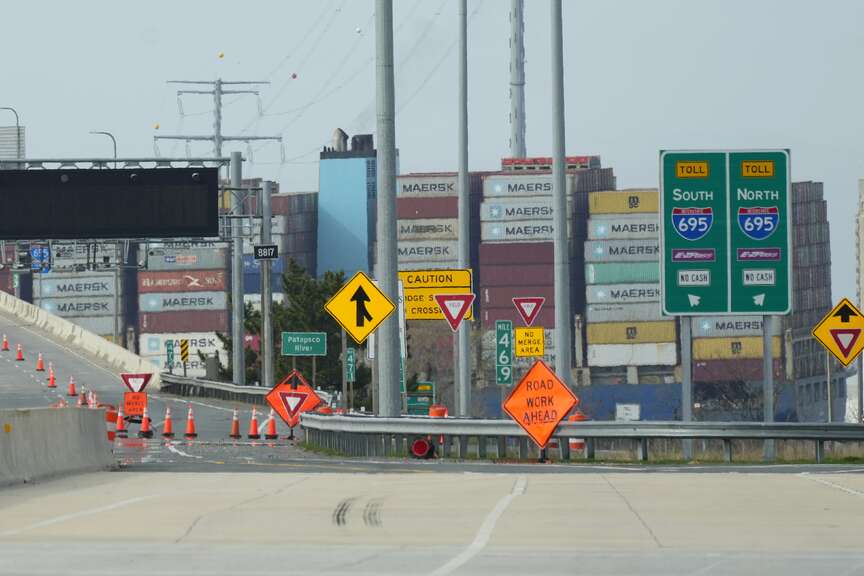 A container ship as it rests against wreckage of the Francis Scott Key Bridge on Tuesday, March 26, 2024, as seen from Dundalk, Md. The ship rammed into the major bridge in Baltimore early Tuesday, causing it to collapse in a matter of seconds and creating a terrifying scene as several vehicles plunged into the chilly river below. (AP Photo/Matt Rourke)
A container ship as it rests against wreckage of the Francis Scott Key Bridge on Tuesday, March 26, 2024, as seen from Dundalk, Md. The ship rammed into the major bridge in Baltimore early Tuesday, causing it to collapse in a matter of seconds and creating a terrifying scene as several vehicles plunged into the chilly river below. (AP Photo/Matt Rourke)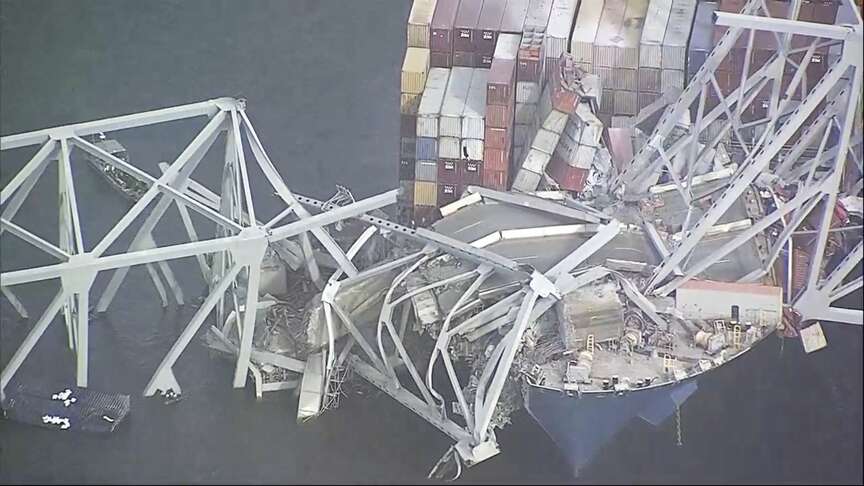 Parts of the Francis Scott Key Bridge remain after a container ship collided with one of the bridge's support Tuesday, March 26, 2024 in Baltimore. The major bridge in Baltimore snapped and collapsed after a container ship rammed into it early Tuesday, and several vehicles fell into the river below. Rescuers were searching for multiple people in the water. (WJLA via AP)
Parts of the Francis Scott Key Bridge remain after a container ship collided with one of the bridge's support Tuesday, March 26, 2024 in Baltimore. The major bridge in Baltimore snapped and collapsed after a container ship rammed into it early Tuesday, and several vehicles fell into the river below. Rescuers were searching for multiple people in the water. (WJLA via AP)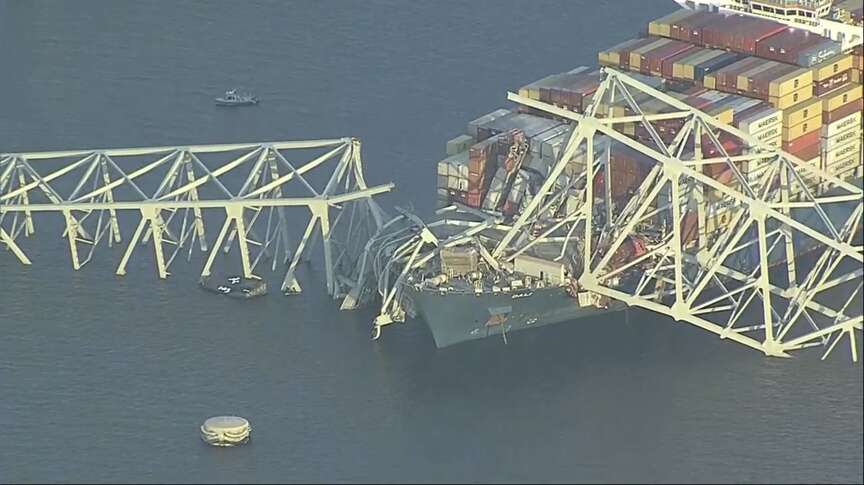 Parts of the Francis Scott Key Bridge remain after a container ship collided with one of the bridge's support Tuesday, March 26, 2024 in Baltimore. The major bridge in Baltimore snapped and collapsed after a container ship rammed into it early Tuesday, and several vehicles fell into the river below. Rescuers were searching for multiple people in the water. (WJLA via AP)
Parts of the Francis Scott Key Bridge remain after a container ship collided with one of the bridge's support Tuesday, March 26, 2024 in Baltimore. The major bridge in Baltimore snapped and collapsed after a container ship rammed into it early Tuesday, and several vehicles fell into the river below. Rescuers were searching for multiple people in the water. (WJLA via AP)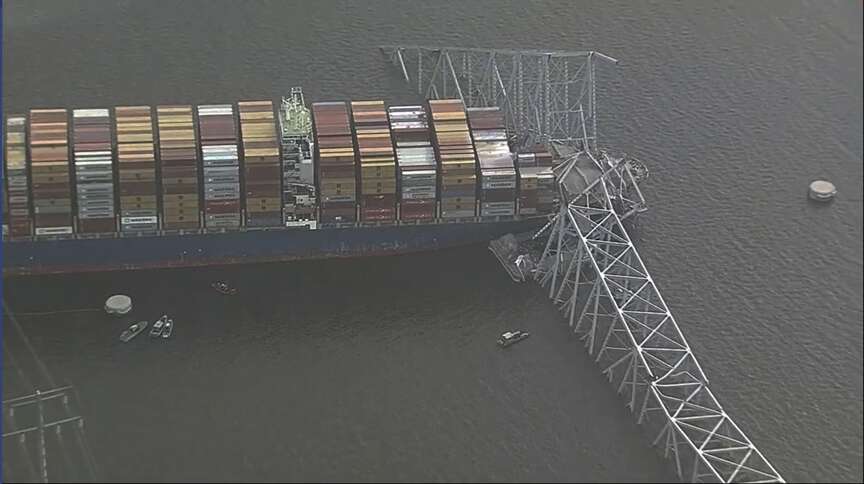 Parts of the Francis Scott Key Bridge remain after a container ship collided with one of the bridge's support Tuesday, March 26, 2024 in Baltimore. The major bridge in Baltimore snapped and collapsed after a container ship rammed into it early Tuesday, and several vehicles fell into the river below. Rescuers were searching for multiple people in the water. (WJLA via AP)
Parts of the Francis Scott Key Bridge remain after a container ship collided with one of the bridge's support Tuesday, March 26, 2024 in Baltimore. The major bridge in Baltimore snapped and collapsed after a container ship rammed into it early Tuesday, and several vehicles fell into the river below. Rescuers were searching for multiple people in the water. (WJLA via AP)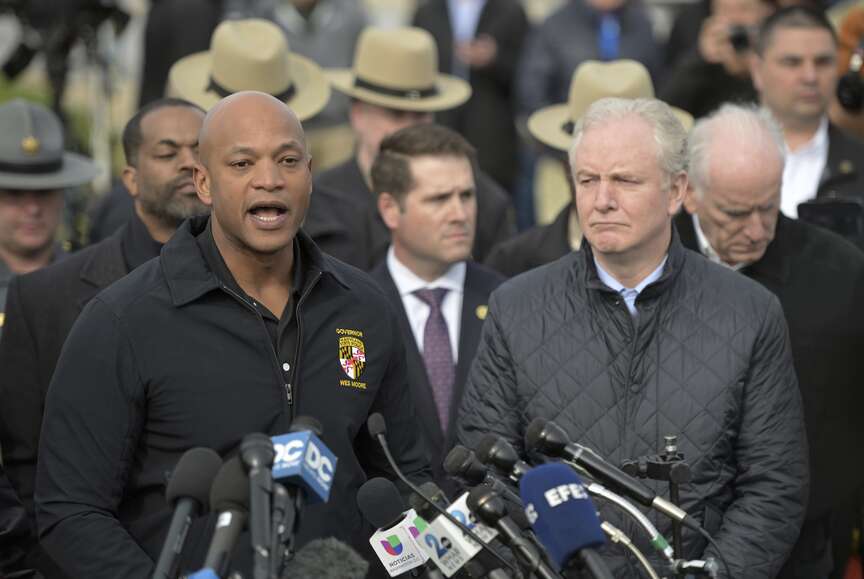 Maryland Gov. Wes Moore, left, speaks during a news conference as Sen. Chris Van Hollen (D-MD) looks on near the scene where a container ship collided with a support on the Francis Scott Key Bridge, Tuesday, March 26, 2024 in Baltimore. The major bridge in Baltimore snapped and collapsed after a container ship rammed into it early Tuesday, and several vehicles fell into the river below. Rescuers were searching for multiple people in the water. (AP Photo/Steve Ruark)
Maryland Gov. Wes Moore, left, speaks during a news conference as Sen. Chris Van Hollen (D-MD) looks on near the scene where a container ship collided with a support on the Francis Scott Key Bridge, Tuesday, March 26, 2024 in Baltimore. The major bridge in Baltimore snapped and collapsed after a container ship rammed into it early Tuesday, and several vehicles fell into the river below. Rescuers were searching for multiple people in the water. (AP Photo/Steve Ruark)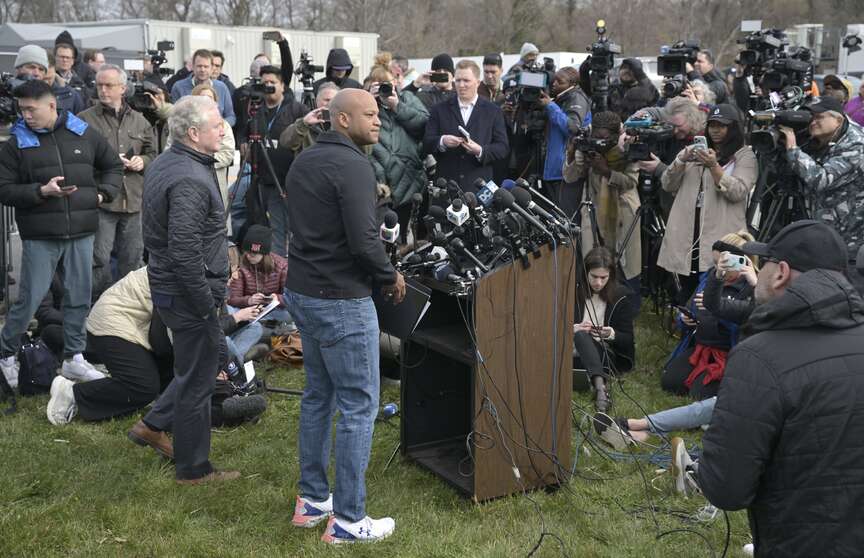 Maryland Gov. Wes Moore, center, holds a news conference near the scene where a container ship collided with a support on the Francis Scott Key Bridge, Tuesday, March 26, 2024 in Baltimore. The major bridge in Baltimore snapped and collapsed after a container ship rammed into it early Tuesday, and several vehicles fell into the river below. Rescuers were searching for multiple people in the water. (AP Photo/Steve Ruark)
Maryland Gov. Wes Moore, center, holds a news conference near the scene where a container ship collided with a support on the Francis Scott Key Bridge, Tuesday, March 26, 2024 in Baltimore. The major bridge in Baltimore snapped and collapsed after a container ship rammed into it early Tuesday, and several vehicles fell into the river below. Rescuers were searching for multiple people in the water. (AP Photo/Steve Ruark)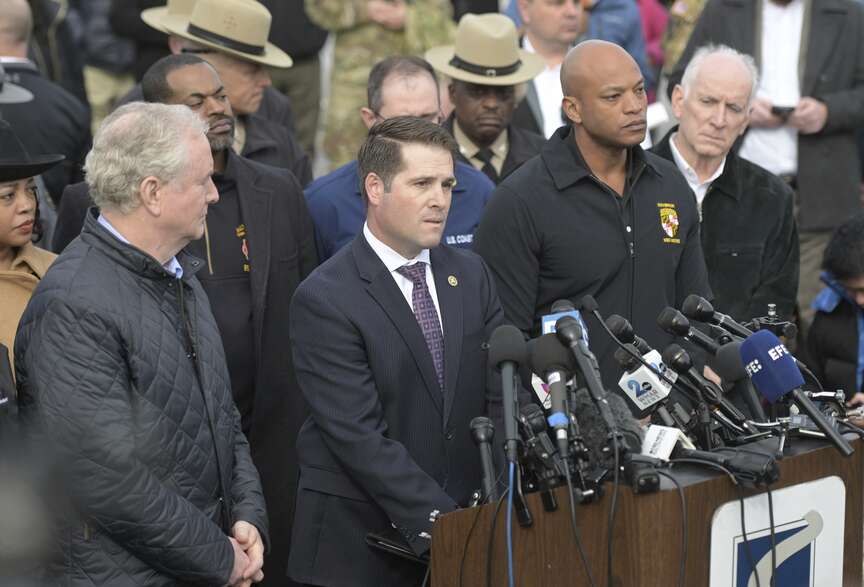 From left, Sen. Chris Van Hollen (D-Md.), Bill DelBagno, FBI special agent in charge of the Baltimore field office, Maryland Gov. Wes Moore and Paul J. Wiedefeld, Maryland's transportation secretary, hold a news conference near the scene where a container ship collided with a support on the Francis Scott Key Bridge, Tuesday, March 26, 2024 in Baltimore. The major bridge in Baltimore snapped and collapsed after a container ship rammed into it early Tuesday, and several vehicles fell into the river below. Rescuers were searching for multiple people in the water. (AP Photo/Steve Ruark)
From left, Sen. Chris Van Hollen (D-Md.), Bill DelBagno, FBI special agent in charge of the Baltimore field office, Maryland Gov. Wes Moore and Paul J. Wiedefeld, Maryland's transportation secretary, hold a news conference near the scene where a container ship collided with a support on the Francis Scott Key Bridge, Tuesday, March 26, 2024 in Baltimore. The major bridge in Baltimore snapped and collapsed after a container ship rammed into it early Tuesday, and several vehicles fell into the river below. Rescuers were searching for multiple people in the water. (AP Photo/Steve Ruark)